

View-Master owed a large amount of its success to the various children's entertainment
reels. Florence Thomas was the first and probably the greatest 3D artist in the View-
Master studios. She was certainly the most prolific. She originated many of the
techniques for making stunningly beautiful 3D reels between the late 1940s and the early
1970s. Not much is published about her life, but her artistic life and development are
clearly shown in the beautiful View-Master pictures she created. Her artistry certainly
contributed to the View-Master success. She started work at Sawyers in 1944 and retired
in 1971, but some of her work still came out in 1975.
Florence was a master sculptor and made the miniature figurines out of clay. She painted
them with appropriate colors and fabric patterns. She also created the dioramas and
arranged the lighting. Originally she reputedly also did the photography, but later it was
done by others. From the photo evidence she first photographed the left then the right
eye view, shifting the camera in between exposures. The order of the picture taking can
be clearly seen in some reels with candles because the left view shows a longer unburned
part.
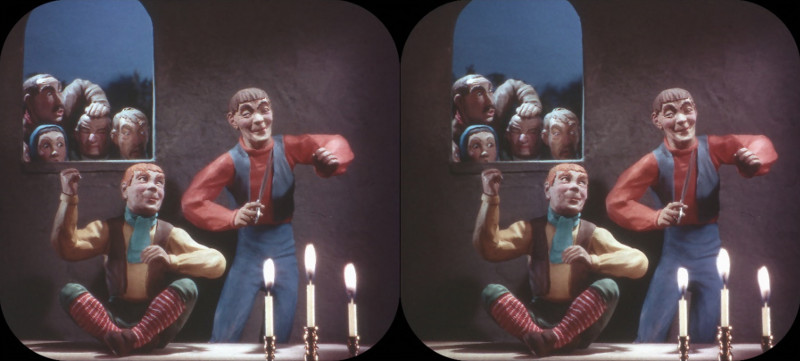
Between the two exposures she would also shift and rotate some items to enhance the 3D
effect.
Her artistry changed with time. The six earliest reels had a slightly funky primitive look
with great vitality and strongly expressed emotions. The figurines were created by
Hollywood artists and Florence worked on the dioramas, but she created the 1948
figurines. All of her 1946 and 1948 dioramas have a beautifully painted background and
great depth.
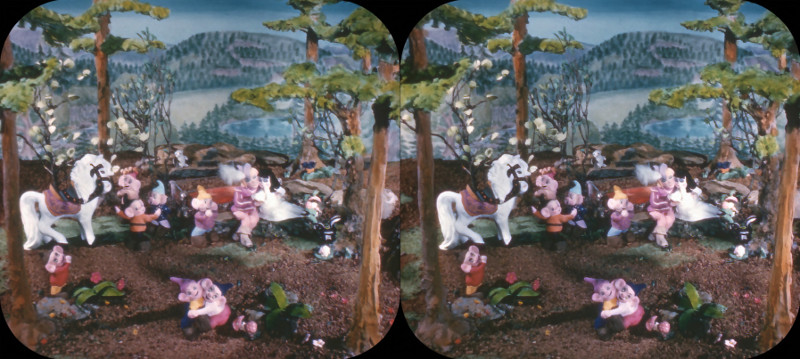
By contrast the final scene in her 1955 three-reel packet has figurines by Ms. Thomas. The
figures are much more realistic and include the 3 faithful animal companions. The
foliage is much more natural and the background has all 3D imagery. The figurines are
more like Meissen porcelain without the cartoonish quality of the Hollywood artists.
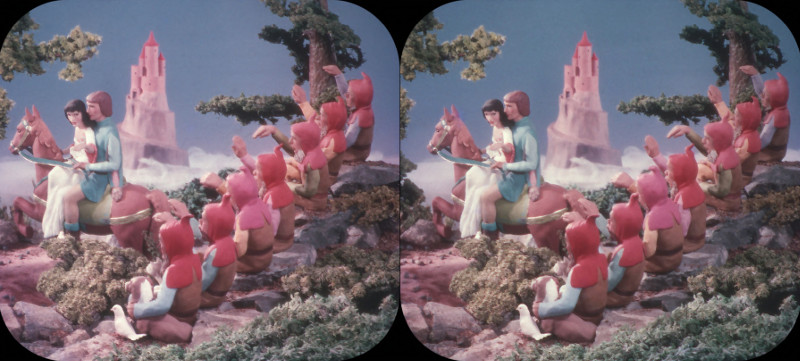
The previous scene just after she awoke does show some happiness, but the prince and
Snow White have more ambiguous expressions. This scene is more intimate with larger
figures in its presentation with only hints of great depth.
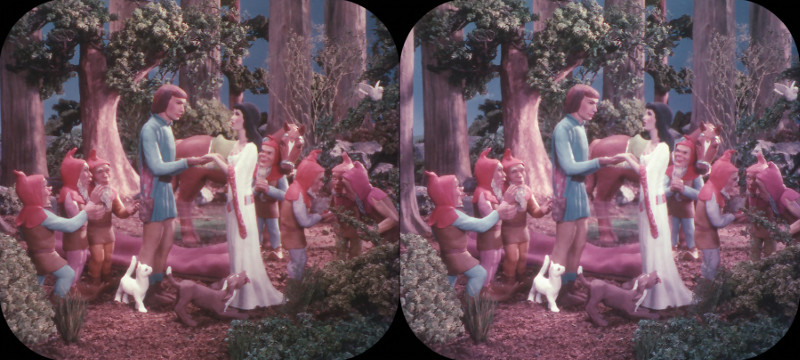
The Snow White set clearly shows her skill at sculpting cute pets. One gets the feeling
that she loved cats and dogs. She even sneaked them into some of her bible stories. The
account by Mary Ann Sell says that in retirement Florence gardened while watched by
her beloved cat.
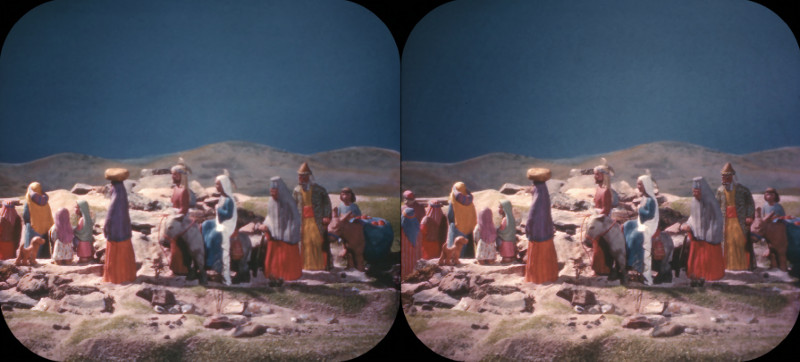
A personal favorite with pets is from her early set of Nursery Rhymes
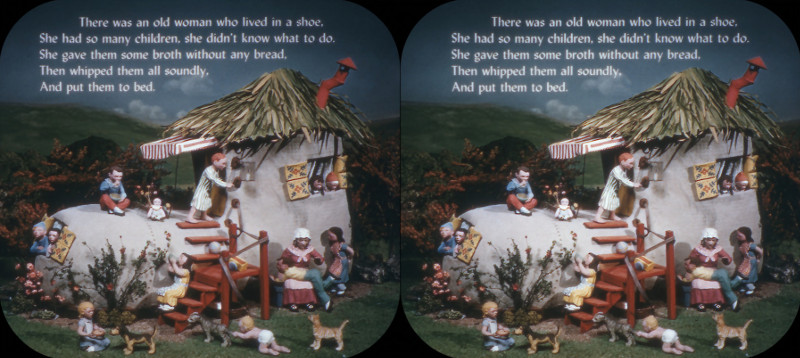
Her "Puss in Boots" packet allowed her free reign in crafting the crafty cat
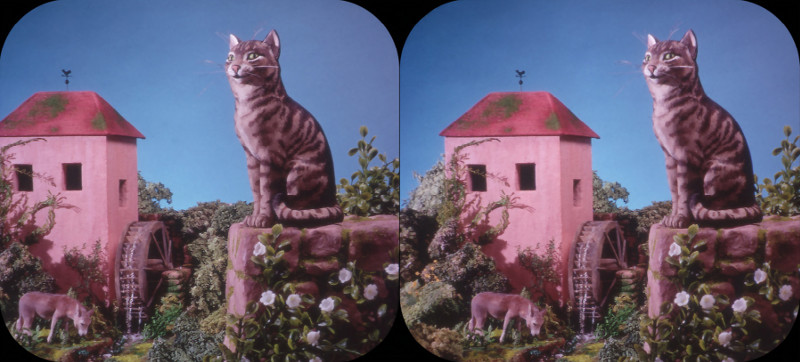
She had a genius for squeezing in all of the details of a story within a single reel, or even a single picture.
Notice the other verses appear in this picture.
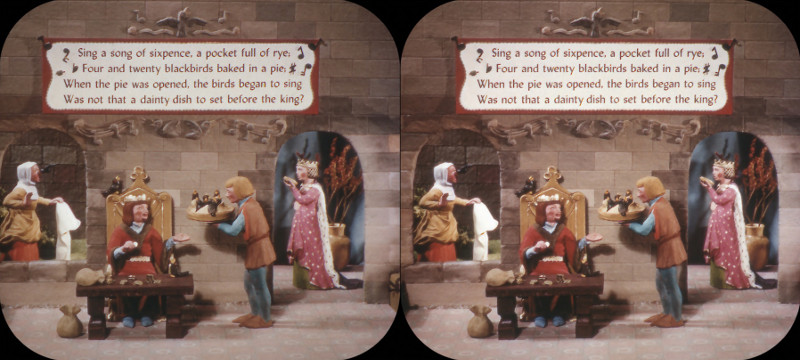
| When the pie was opened, The birds began to sing; Wasn't that a dainty dish, To set before the king? | The king was in his counting house, Counting out his money; The queen was in the parlour, Eating bread and honey. | The maid was in the garden, Hanging out the clothes, When down came a blackbird And pecked off her nose |
Her work was very carefully and beautifully crafted. With all the many thousands of pictures
she created only a few with obvious goofs. By shifting objects from one picture to another there
are sometimes evident artifacts. This happens several times in her 1946 Fairy Tales and her
1948 Christmas story. The foliage in some of the fairy tales had dramatically different shading.
The shadow just behind the right shepherd's head is much deeper on the left frame.
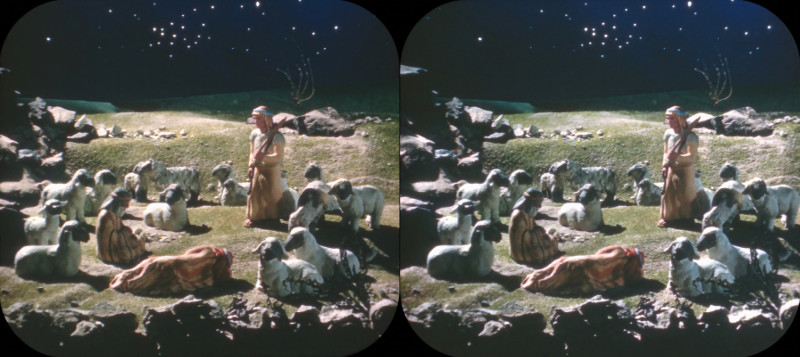
The pike in the following scene was apparently shifted and one piece of seaweed moved the
wrong way. The strand to the left in front of the pike appears to be embossed inside him. The
effect is on the edge and is very subtle. For the readers who can't "freeview" parallel, the left
picture should show the seaweed much farther to the right if it is in front of the pike. This may
be her only Disney set of reels.
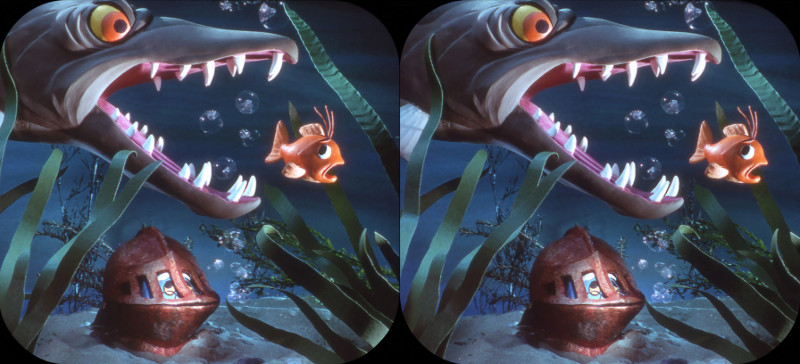
Florence created all kinds of stories from fairy tales, classic stories, bible stories to Disney movie
stories. Here is a picture from her "Aesop's Fables" packet. The dog has seen a reflection of his
own bone in the pond. He thinks it is bigger so he jumps in to get it and loses his original bone.
It must be seen in 3-D to appreciate the great artistry.
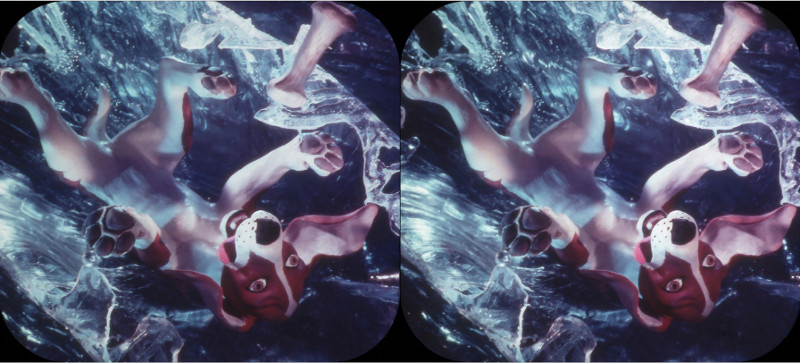
An example of a contemporary story set is the Tom Corbett packet based on a space opera
character in radio and movie plays. Notice that Dr. Dale is using a 3D camera!
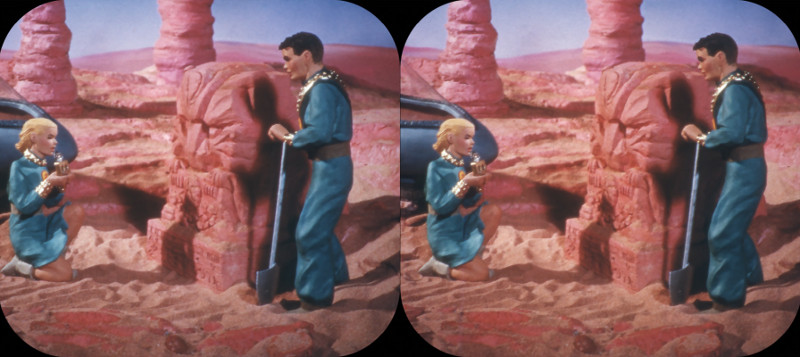
The art of 3D photography is very different from conventional flat picture taking. The frame
should always be in front of objects at the edges because they look strange and have difficult to
view cut off edges. Objects in the middle can come forward in front of the frame, but this can
easily become tiring to view if done frequently. View-Master slides generally were carefully
aligned to put everything behind the frame. There is one example of where one of Florence's
pictures violated this convention to make Tiny Tim and Scrooge look extremely welcoming by
having them in front of the frame holding arms toward you.
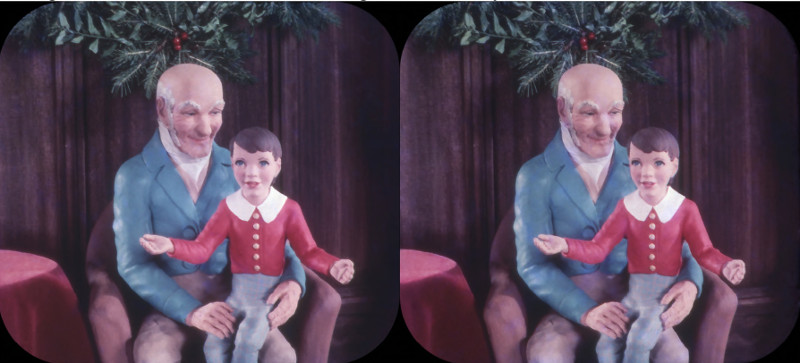
All of her creations are beautiful and some beautifully interpret classic drawings. In the same
Christmas Carol packet Mr. Fezziwig's ball has the essentials of the often reproduced original
classic drawing, but adds some details. Notice the drinker, the muncher, and the whirling
dancers. To a dancer it evokes a real ball.
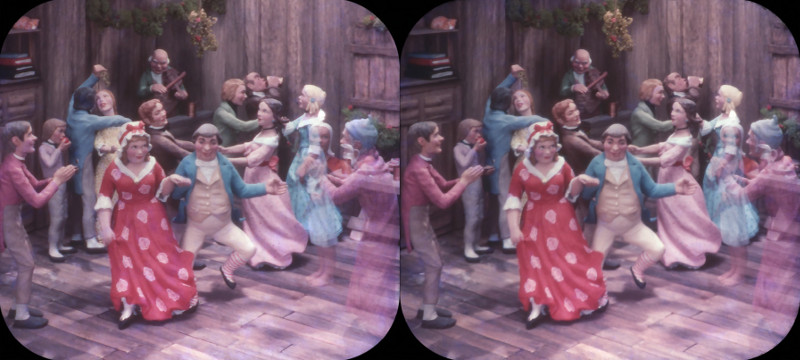
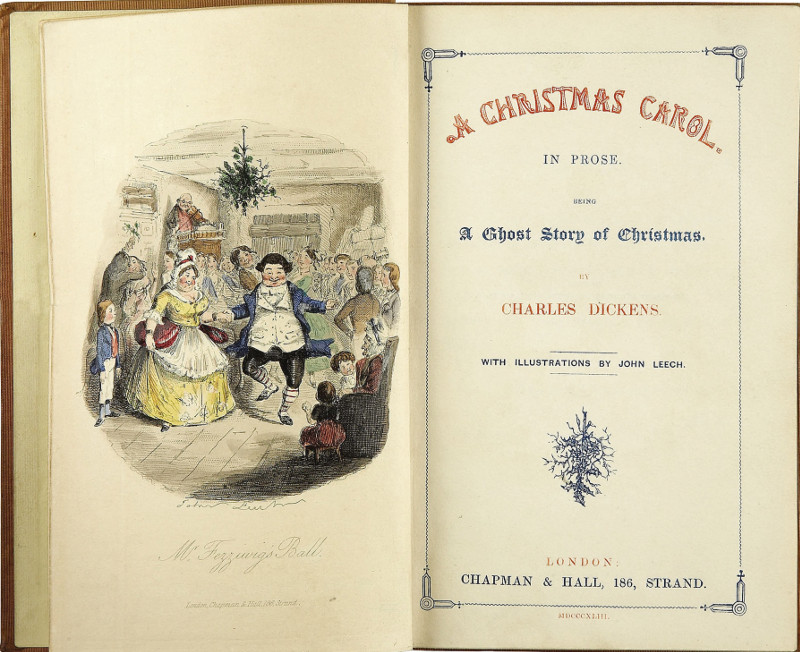
Her "Alice in Wonderland" and "Through the Looking Glass" evoke the original John Tenniel
drawings, not the Disney movies.
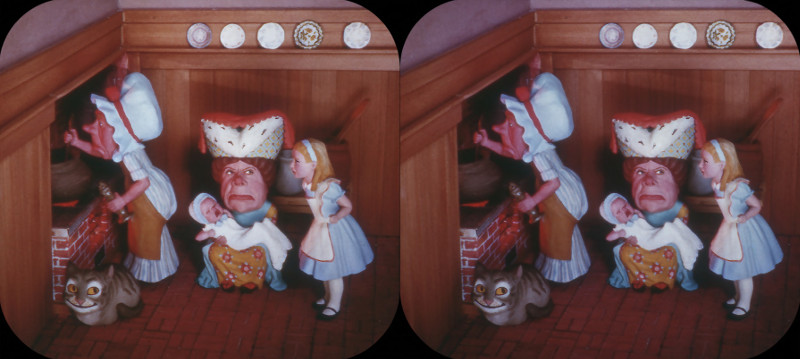
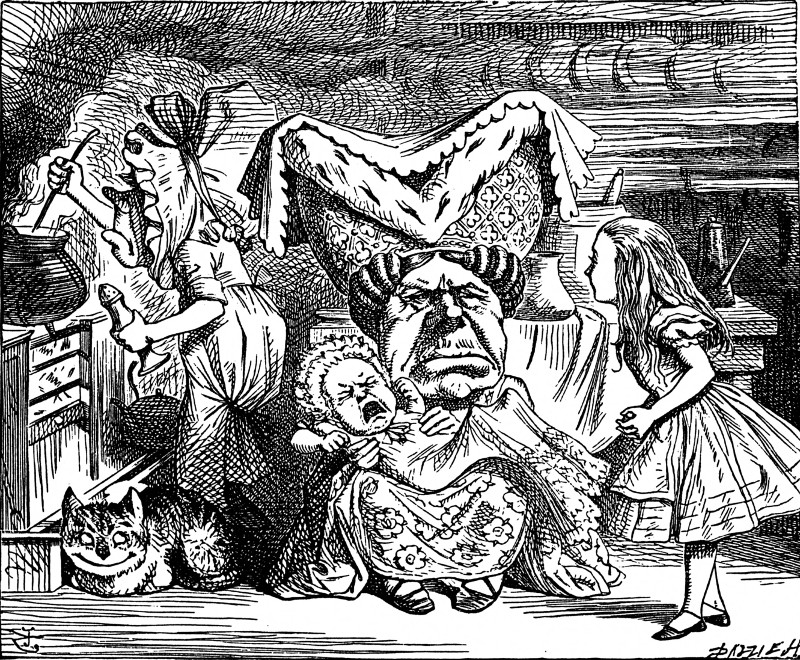
If I were to pick one picture which I like the most, "Mr Fezziwig's Ball" would come out near
the top.
One that I find also appeals the most is the winter scene from "The Ugly Duckling". It is typical
of her early work with a sweeping deep vista. The duckling is taking shelter and the whole scene
evokes the long winters of my childhood in upstate NY.
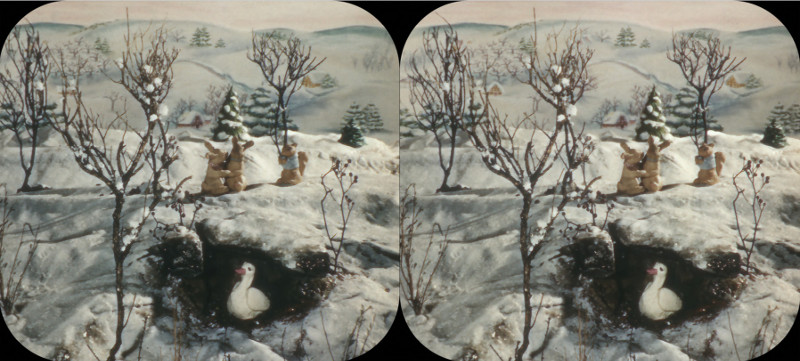
Her most sensuous picture is from one of her "Bible Heroes" stories.
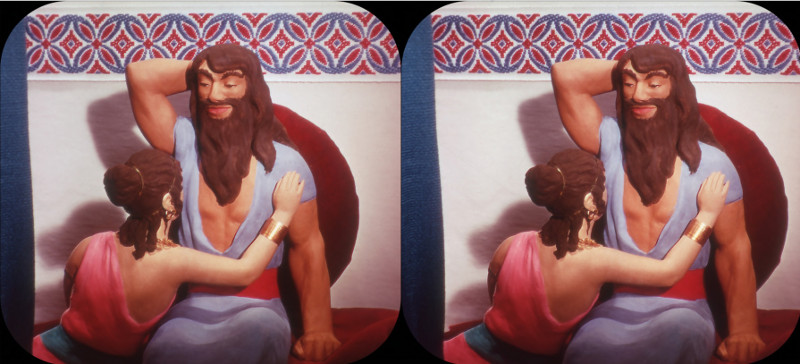
One often wonders what it would be like to sit down and talk to her. Unfortunately the pictures
only give hints of what she might have been like. I personally think they show a very private
person who was a true artist. Her figurines and dioramas were all made of impermanent
materials. In particular the figurines were probably never fired at high temperatures for
permanence. Just like many theater and movie sets the physical artwork was not valued at the
time so it was discarded. All we have are the final published beautiful pictures. Fortunately all
of her work was originally published using Kodachrome film stock which has an extremely long
life, so her work can still be enjoyed and acquired on the used market. The later View-Master
reels after 1976 were all on inferior stock which turns red in about 20 years. It has been
reported, that View-Master discarded all of the original large format slides in the 1970s, so new
high quality reprints are now impossible. Both the physical artwork and the original slides
would fetch fancy prices now, but they threw it all out.
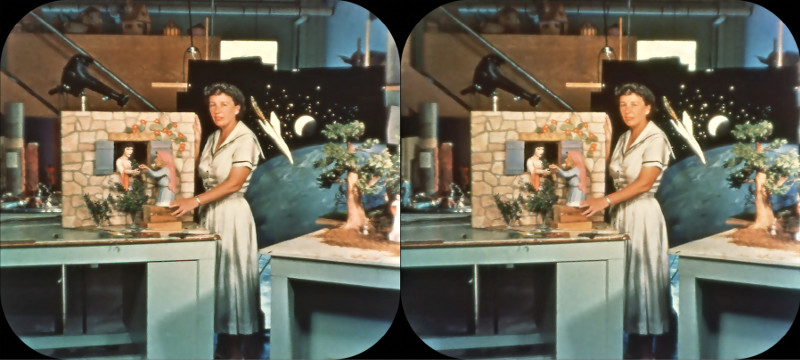
This is a reprint of an original picture in the "Christmas Tour of Sawyers" made in the early
1950s. The reprint was made for the NSA meeting in 1989 and still available new on
impermanent film stock. The reprint was made from a reel, not the original slide, and as a result
it has lots of noise, poorer color, with little fine detail.
The shot shows her with works in progress in her studio. Above the cabinet in the back you can
clearly see various houses to be recycled into new dioramas. On the right of the houses it looks
like some backgrounds for her ABC Alphabet Circus. The spaceship behind her on the right is
from the penultimate picture in the Tom Corbett packet. The diorama on the right and the one in
the center appear in her "Snow White" 3 reel packet. The figures to the left by the books are
resting while awaiting being put on stage. According to an interview on the Sawyers Story film
it took her a year to finish a reel packet. Of course she would be working on several reels
simultaneously.
The diorama in the center of the previous picture is actually is an incomplete work in progress.
The final picture had the same figures, but different shutters and curtains.
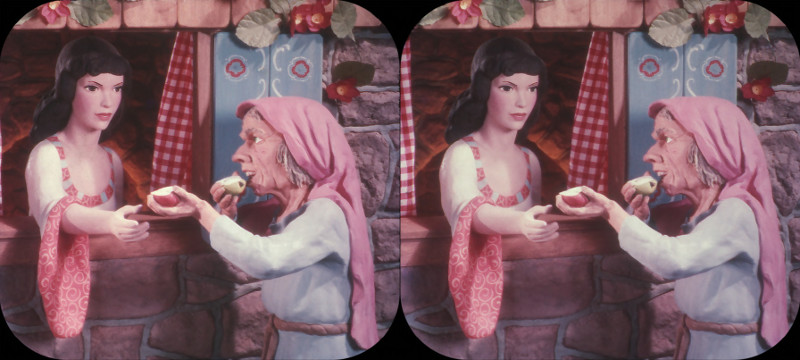
The penultimate Tom Corbett scene as shown in her workshop.
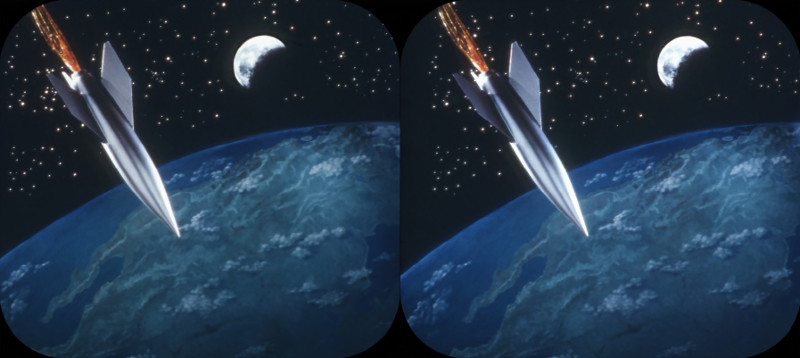
Some of the fun of her reels is to observe at how she varied the presentations. She recycled the
same figurines in different scenes, but changed the angle to disguise the similarity. She also used
the same houses with just a bit of redecoration, especially in her early reels. It is also a pleasure
to see how her work evolved with time. Some of the earliest reels were redone by her several
years later in a very different style. With her beautiful renditions of fairy tales why did View-
Master later redo some of her reels with different artists? There is no accounting for tastes,
fashions, and corporate profit.
The following picture shows how she used paper cutouts to evoke a cartoon effect while the
foreground is fully sculpted. To my knowledge she never repeated this effect although she did
use paper cutouts in constructing some items in dioramas.
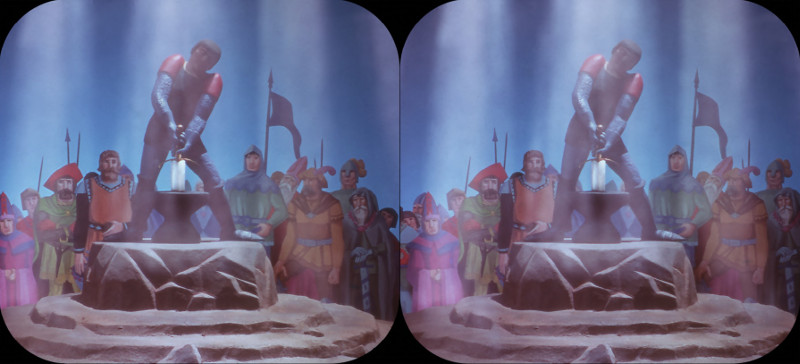
Florence used double exposures to achieve ghostly transparent effects and this is done frequently
to good effect in the Arabian Nights series. The glittering palaces, profuse gardens, and fantastic
geniis make this my favorite series.
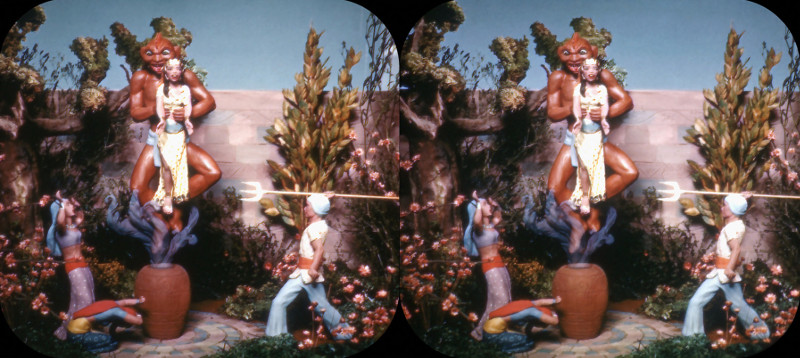
There are many beautiful View-Master scenes lying in wait on the used reel market by Florence
and other artists. There are also a number of digitized reels on the web including YouTube.
Some of the post 1976 reels which have all turned red have been restored and are only available
in the original color on the web. Fortunately all of Florence's pictures are available in unfaded
glorious Kodachrome. View-Master was originally designed for family pleasure and not just
children. The pleasures of Florence's pictures can be enjoyed by all.
The View-Master pictures used in this document were all restored by the author from his
collection. Some information came from the book "View-Master Memories" by Mary Ann Sell,
Wolfgang Sell, and Charley Van Pelt, 2007. It contains a decent article on Ms. Thomas, and has
lots of details about the other View-Master artists.
A partial list of Florence Thomas' work
1946 FT-1 Little Red Riding Hood, figurines by Hollywood artists
1946 FT-2 Hansel and Gretel, figurines by Hollywood artists
1946 FT-3 Jack and the Beanstalk, figurines by Hollywood artists
1946 FT-4 Snow White and the Seven Dwarfs, figurines by Hollywood artists
1946 FT-5 Cinderella, figurines by Hollywood artists
1946 FT-6 Goldilocks and the Three Bears, figurines by Hollywood artists
1948 FT-7 The Three Little Pigs
1948 FT-8 Little Black Sambo
1948 FT-9 The Ugly Duckling
1948 XM-1,2,3 The Christmas Story
1950 EA-1,2,3 The Easter Story
1950 MG-1,2,3 Mother Goose
1951 FT-50 Aladdin and the Wonderful Lamp, 2 reels
1951 FT-51 The Magic Carpet
1952 FT-1B Little Red Riding Hood
1952 FT-2B Hansel and Gretel
1952 FT-3B Jack and the Beanstalk
1952 FT-20 Alice in Wonderland, packet
1952 FT-30 The Night before Christmas
1953 FT-5 Cinderella
1953 FT-10 Sleeping Beauty
1953 FT-11 The Pied Piper
1953 FT-12 Thumbelina
1954 970A, B, C Tom Corbett Space Cadet, packet
1955 FT-13 Rumplestiltskin
1955 FT-25 Rudolph the Red Nosed Reindeer
1956 FT-31 A Christmas Carol
1958 B305 Hans Christian Anderson's Fairy Tales, packet
1959 B309 Aesop's Fables, packet
1960 B312 The Elves and the Shoemaker, Grimm's Fairy Tales packet
1961 B411 ABC Circus, packet
1962 B412 1-2-3 Farm, packet
1962 B901 The Seven Wonders of the World, packet with Lelia Heath, Frank Visage
1963 B316 The Sword in the Stone, packet
1965 B851 Noah's Ark, packet
1967 B852 Bible Heroes, packet
1970 B853 Moses and the Plagues of Egypt, packet with Mary Lewis
1972 B854 Moses and the Ten Commandments, packet
1975 B364 Alice Through the Looking Glass, packet
Some of the later reels credited the artists, but often it is not possible to discover exactly who did
what. Other View-Master artists also created very nice reels in different styles. Many reels are
available at reasonable prices on the used market. A number of reels have been reissued with
different numbering, but the title and copyright dates remained the same so it is sometimes
possible to determine the contents. Beware of all copyrights after 1977 and some in 1977 as they
have turned red. Beware of GAF reissues because if manufactured after 1976 they may have
turned red. Always inquire about GAF reels as to whether they have turned red.
If you really want pictures on post 1976 reels, that have turned red, it is possible to scan them
and correct the color using the Kodak Digital ROC plugin. A high resolution flatbed scanner can
be used and the free Stereo Photo Maker can properly align the 3D images. The sharpness can
best be improved using Focus Magic. The hard part is locating and removing each defect. When
viewed in 3D using Stereo Photo Maker the defects are obvious so a competent, reasonably
priced, photo editor such as Paint Shop Pro can be used to fix them. When scanned at 6400dpi
and corrected in several passes by Focus Magic, near 4K resolution can be achieved.
If you wish to view these in good 3D you can buy the reels used from various sources or print the
pictures and cut them to 7 inch wide cards. They will fit into a Holmes stereoscope which is
available either as a kit or assembled from many stores on the web.